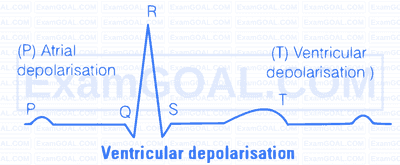Complete the missing word in the statement given below
(a) Plasma without ............ factors is called serum.
(b) .............. and monocytes are phagocytic cells.
(c) Eosinophils are associated with ............. reactions.
(d) ............ ions play a significant role in clotting.
(e) One can determine the heart beat rate by counting the number of ............ in an ECG.
(a) Plasma without clotting factors is called serum.
(b) Neutrophils and monocytes are phagocytic cells.
(c) Eosinophils are associated with allergic reactions.
(d) Calcium ions play a significant role in clotting.
(e) One can determine the heart beat rate by counting the number of QRS complex in an ECG.
Given below is the diagrammatic representation of a standard ECG. Label its different peaks.

The representation of a standard ECG diagram

Given below are the abnormal conditions related to blood circulation. Name the disorders
(a) Acute chest pain due to failure of $\mathrm{O}_2$ supply to heart muscles
(b) Increased systolic pressure
(a) Angina also called as 'angina pectoris'. It a symptom of acute chest pain that appears when there is no enough oxygen is reaching to the heart muscle. Angina can occur in men and women of any age but it is more common among the middle aged and elder people. It occurs due to condition that affect the blood flow (hypertension etc.)
(b) High Blood Pressure (hypertension) is the term for blood pressure that is higher than normal ( $120 / 80$ ). In this measurement 120 mm Hg is the systolic, or pumping pressure and 80 mm Hg is the diastolic or resting pressure.
Increased systolic pressure, i.e., 140/80 or 150/80, shows hypertension. High blood pressure leads to heart diseases and also affects vital body organs like brain and kidney.